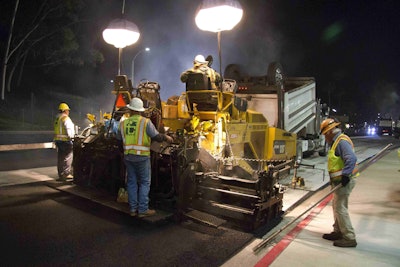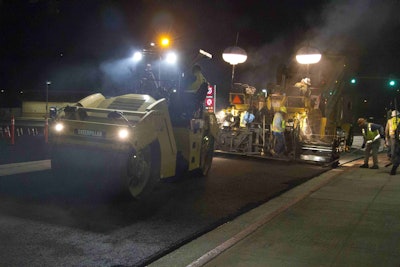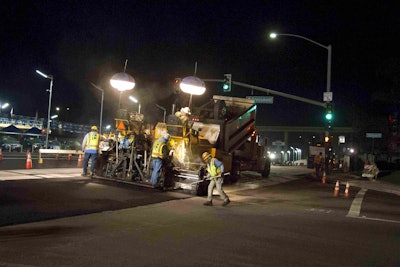How one firm successfully expanded its paving operations
.

Until a few years ago, TC Construction Company Inc. was primarily an underground utility contractor that mixed in a little bit of everything else. Its offerings included wet and dry utilities; water and wastewater pumping stations; and small grading work. The firm even did some paving — mostly trench patching.
In 2006, TC turned its occasional paving efforts into a full-fledged offering: It moved into the production paving business. The Southern California firm most certainly did so with its eyes wide open.

The veterans who work with Cameron agree that paving presents unique challenges. They also agree that adding paving to the company’s offerings has created many opportunities.
What are the benefits of adding production paving capabilities, and how can a contractor help ensure a move into the paving industry is a success?
The TC Construction team — consisting of Cameron and key superintendents Jeep Tharp, Vic Lewis, John Willson, Rick Halm and estimator Art Hernandez — have some hints on why and how to make the change.
Adding Paving Capabilities
TC started as an underground utility and earthmoving company. Its range of services soon included crushing, material recycling and erosion control. “Some of these areas we simply had to offer because they’re part of our process,” Tharp says. Erosion control, for example, is extremely important throughout Southern California and goes hand-in-hand with the other trades TC performs.

“We never did overlays,” Willson says. “In those days, 2006 and before, we did 10,000-15,000 tons per year.”
In late 2006 and early 2007 TC decided to make a move into production paving, and its growth has been impressive: Last year, the company placed about 200,000 tons. “We’re certain an expansion into paving was the right decision,” Cameron says. “The numbers are starting to show that.”
So why did TC expand its offerings to include paving?
-
Larger jobs are there for the taking. Many customers want a one-stop shop, Lewis says. “We can do the underground work, and the paving, and the customer only has one point of contact,” he adds. “They save time not having to schedule two different subs for the underground work, and then the paving. We just handle it. It’s a lot easier for the customer.”
-
Improved efficiency. TC gains efficiencies from handling all aspects of the job. Those efficiencies, in turn, can be passed along to customers in the form of lower bids. Lower bids, of course, lead to more work. “Offering that complete package makes us more competitive,” Halm says.
-

Sometimes a production crew might be relocated to handle trench patching for a day or two to complete jobs on schedule.
“It means we don’t have a job that’s 95 percent done, and then sits for three months,” Willson points out.
The various crews, including paving, sometimes begin their portion of a project earlier.
“We’re willing to work around each other,” Halm says. “We don’t need 100 percent of one phase to be completed before we start another. Some contractors require that.”
The result is quicker completion, more deadlines met and happier customers.
Diversity for growth, tips for survival
TC has endured the recession and wants a more diverse customer base, Cameron said.

Goals of diversification and expanding capabilities are one thing, making it happen another. The TC management team has been through the changes. What advice would they offer?
-
Consider buying a paving firm. “We branched into the paving business when we bought a paving company,” Cameron says. Doing so provided equipment at a reasonable rate. Perhaps more important, the purchase provided an experienced crew.
-
Be patient. “There’s a lot of growing to do until you get all the parts together,” Willson says. “Realize it will take some time to get really good at it. Know that going in.”
-

-
Find a good estimator. “You need to understand the costs,” Halm says. TC hired estimator Art Hernandez, who has 30 years experience in the San Diego area paving business. “He is very knowledgeable, and his experience was crucial at the start,” Cameron says. “Estimating paving takes a great deal of knowledge and experience. Without that experience, it would be hard to provide accurate estimating when you’re starting a new division.”
-

-
Add the right people. Paving crews need more supervision than earthmoving and utility crews, Cameron said. “Since material is such a large factor in paving cost, our crews have zero margin for error, which in turn requires intense supervision,” Cameron said. “Someone has to be on top of what is happening and responsible because a paving mistake is usually much more costly to fix than some other types of construction.”
The “right people” also includes operators. “Find the really good operators, because they solve so many problems before they happen,” Lewis said. That search should be ongoing, he says.
Willson believes there is yet another aspect to the “right people.” With paving, he says, “You need a good team, and people who can get along with one another. Paving is different than, say, underground work. A paving crew has 11-12 guys within 30 to 40 feet of each other — all day, every day. They have to get along, know their responsibilities, be on the same page, be respectful of others and be safe.”
-

Ultimately, the move into paving is well worth the effort, Cameron says. “We feel we’re stronger positioned than ever before,” he says. “It’s not easy, but if the commitment is there, you can get it done.”
This article was contributed by High Velocity Communications on behalf of TC Construction.


















